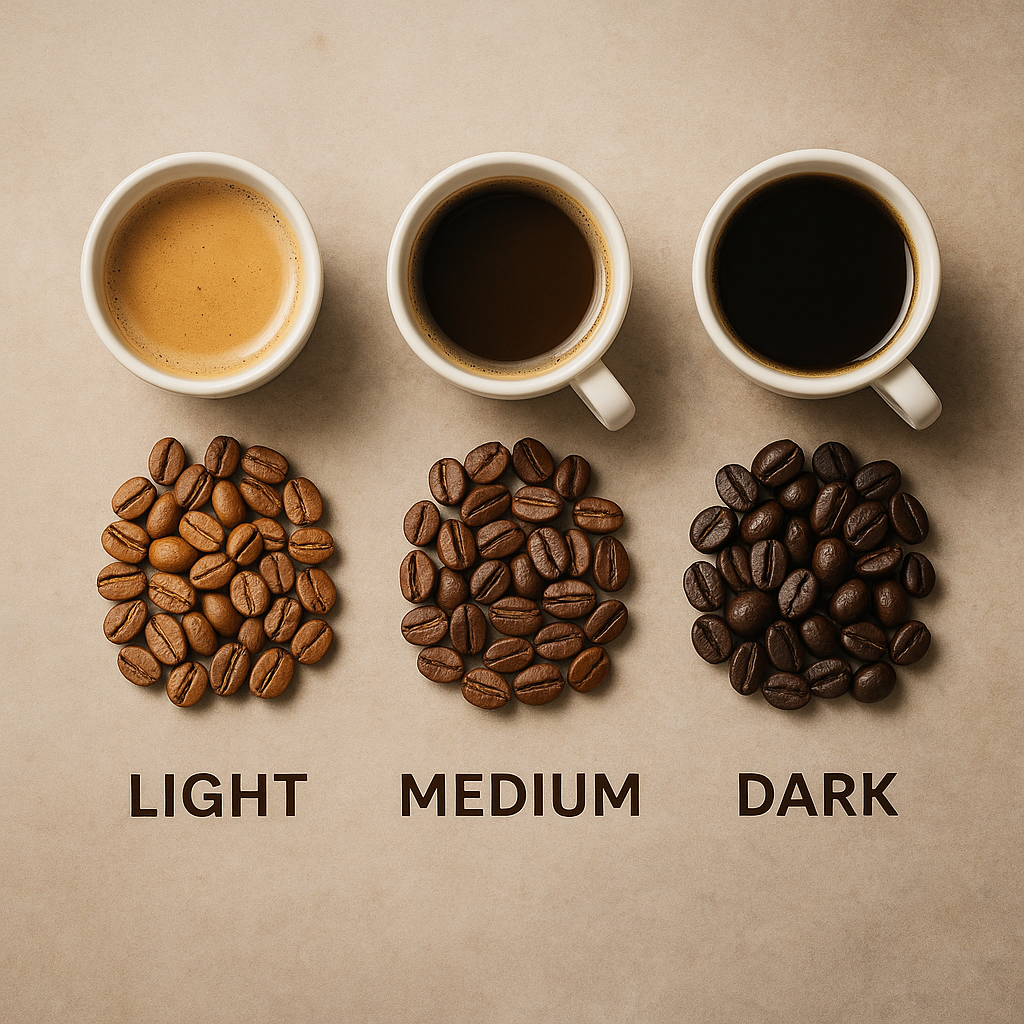Coffee lovers often hear about light, medium, and dark roasts, but many people still wonder what those terms really mean—and how they impact the flavor in the cup. Whether you’re brewing at home or ordering from a specialty café, understanding the roast level can help you choose the perfect coffee for your taste.
Below, we answer the most common questions about coffee roast levels and explain how each one changes the aroma, body, and flavor of your brew.
What Does “Roast Level” Mean?
Roast level refers to how long and at what temperature coffee beans are roasted after they’ve been harvested and processed. The longer the roast, the darker and oilier the beans become. Coffee beans start out green and soft. Roasting turns them brown and crunchy, unlocking the aromas and flavors we associate with coffee. The level of roast affects flavor notes (e.g., fruity, nutty, smoky), acidity, body (light or full), caffeine content, and aroma.
What Is Light Roast Coffee?
What does light roast coffee taste like?
Light roast coffee preserves most of the bean’s original characteristics. It tends to have bright acidity, floral or fruity notes, and a light body. Because the beans are roasted for less time, they don’t develop strong caramelized or roasted flavors.
Flavor profile examples: Citrus, berry, apple, jasmine, tea-like
Color of beans: Light brown, dry surface (no oil)
Best brewing methods: Pour-over, Aeropress, Chemex
Popular with: People who enjoy complex, nuanced flavors and want to taste the bean’s origin
Caffeine level: Slightly more caffeine than dark roasts (but difference is small)
What Is Medium Roast Coffee?
What makes medium roast coffee so popular?
Medium roast is often considered the most balanced roast. It still allows the bean’s origin flavors to shine, but adds a bit of sweetness, body, and mild roast character like chocolate or nuts. It’s the middle ground between bright and bold.
Flavor profile examples: Caramel, milk chocolate, nuts, mild fruit
Color of beans: Medium brown, still dry or slightly shiny
Best brewing methods: Drip coffee, French press, espresso
Popular with: People who like smooth, sweet, and well-rounded coffee
Caffeine level: Slightly less than light roast, slightly more than dark roast
What Is Dark Roast Coffee?
Why does dark roast taste so strong?
Dark roast coffee is roasted the longest, which gives it bold, deep flavors like bittersweet chocolate, toast, or even smoky notes. Much of the original bean flavor is replaced by flavors created during the roasting process.
Flavor profile examples: Dark chocolate, molasses, smoky, roasted nuts, earthy
Color of beans: Dark brown to almost black, oily surface
Best brewing methods: Espresso, Moka pot, drip, cold brew
Popular with: Those who prefer rich, bold coffee with low acidity
Caffeine level: Slightly less caffeine due to longer roast time, but the difference is minimal
Does Roast Level Change the Caffeine Content?
Does dark roast have more caffeine than light roast?
Contrary to popular belief, light roast typically has slightly more caffeine by volume. That’s because the longer roasting process of dark roasts reduces the density of the beans. However, when measured by weight (grams), the caffeine difference is minimal. In practical terms, the caffeine difference is so small that it’s unlikely to impact most drinkers noticeably.
Which Roast Should I Choose?
How do I know which roast is right for me?
It depends on your taste preferences and how you brew your coffee.
Choose light roast if you:
- Like high acidity and complex flavors
- Want to taste the bean’s origin
- Enjoy fruity, floral notes
Choose medium roast if you:
- Prefer a balance of acidity and sweetness
- Like chocolatey or nutty notes
- Want a smooth, versatile coffee
Choose dark roast if you:
- Like bold, intense coffee
- Prefer low acidity and roasted flavors
- Enjoy espresso or strong brews
Final Thoughts: Taste the Difference
Roast level is one of the most important factors in how your coffee tastes. Whether you’re new to coffee or an experienced enthusiast, understanding light, medium, and dark roasts helps you discover new flavors and find what suits you best. Try different roasts from the same origin to see how flavor changes. You might be surprised by how much variety a single bean can offer—just depending on how it’s roasted.
